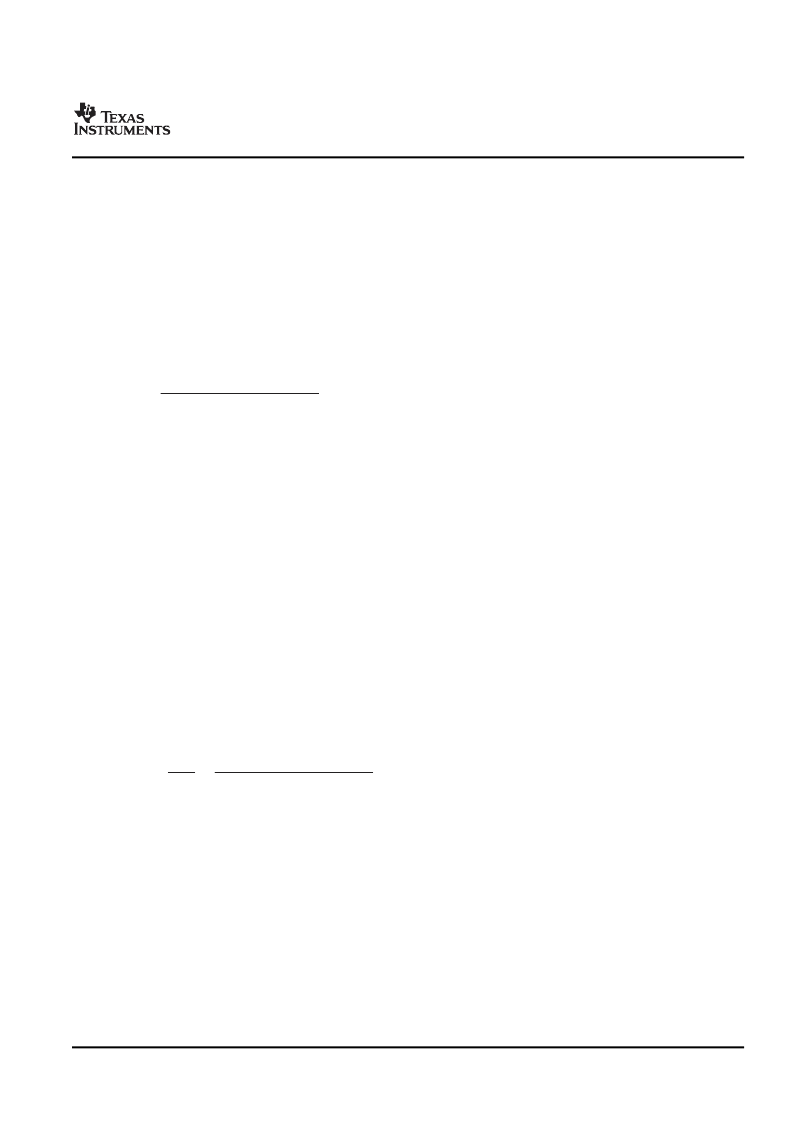- 您現(xiàn)在的位置:買賣IC網(wǎng) > PDF目錄383963 > TPS61026DRC (Texas Instruments, Inc.) 96% EFFICIENT SYNCHRONOUS BOOST CONVERTER PDF資料下載
參數(shù)資料
| 型號(hào): | TPS61026DRC |
| 廠商: | Texas Instruments, Inc. |
| 英文描述: | 96% EFFICIENT SYNCHRONOUS BOOST CONVERTER |
| 中文描述: | 96%高效同步升壓轉(zhuǎn)換器 |
| 文件頁數(shù): | 17/27頁 |
| 文件大小: | 498K |
| 代理商: | TPS61026DRC |
第1頁第2頁第3頁第4頁第5頁第6頁第7頁第8頁第9頁第10頁第11頁第12頁第13頁第14頁第15頁第16頁當(dāng)前第17頁第18頁第19頁第20頁第21頁第22頁第23頁第24頁第25頁第26頁第27頁

www.ti.com
CAPACITOR SELECTION
Input Capacitor
Output Capacitor
Cmin
IOUT
VOUT
V
VBAT
VOUT
(6)
VESR
IOUT
RESR
(7)
SMALL SIGNAL STABILITY
When using output capacitors with lower ESR, like ceramics, the adjustable voltage version is recommended.
The missing ESR can be compensated in the feedback divider. Typically a capacitor in the range of 4.7 pF in
parallel to R3 helps to obtain small signal stability with lowest ESR output capacitors. For more detailed analysis,
the small signal transfer function of the error amplifier and the regulator, which is given in
Equation 8
, can be
used:
AREG
d
VFB
4
(1
(R3
i
R4)
R4
0.9 s)
(8)
LAYOUT CONSIDERATIONS
As for all switching power supplies, the layout is an important step in the design, especially at high peak currents
and high switching frequencies. If the layout is not carefully done, the regulator could show stability problems as
well as EMI problems. Therefore, use wide and short traces for the main current path and for the power ground
tracks. The input capacitor, output capacitor, and the inductor should be placed as close as possible to the IC.
Use a common ground node for power ground and a different one for control ground to minimize the effects of
ground noise. Connect these ground nodes at any place close to one of the ground pins of the IC.
TPS61020
,
TPS61024
,
TPS61025
TPS61026, TPS61027, TPS61028
TPS61029
SLVS451D–SEPTEMBER 2003–REVISED FEBRUARY 2006
At least a 10-μF input capacitor is recommended to improve transient behavior of the regulator and EMI
behavior of the total power supply circuit. A ceramic capacitor or a tantalum capacitor with a 100-nF ceramic
capacitor in parallel, placed close to the IC, is recommended.
The major parameter necessary to define the output capacitor is the maximum allowed output voltage ripple of
the converter. This ripple is determined by two parameters of the capacitor, the capacitance and the ESR. It is
possible to calculate the minimum capacitance needed for the defined ripple, supposing that the ESR is zero, by
using
Equation 6
:
Parameter
f
is the switching frequency and
V is the maximum allowed ripple.
With a chosen ripple voltage of 10 mV, a minimum capacitance of 24 μF is needed. The total ripple is larger due
to the ESR of the output capacitor. This additional component of the ripple can be calculated using
Equation 7
:
An additional ripple of 16 mV is the result of using a tantalum capacitor with a low ESR of 80 m
. The total
ripple is the sum of the ripple caused by the capacitance and the ripple caused by the ESR of the capacitor. In
this example, the total ripple is 26 mV. Additional ripple is caused by load transients. This means that the output
capacitor has to completely supply the load during the charging phase of the inductor. A reasonable value of the
output capacitance depends on the speed of the load transients and the load current during the load change.
With the calculated minimum value of 24 μF and load transient considerations the recommended output
capacitance value is in a 47 to 100 μF range. For economical reasons, this is usually a tantalum capacitor.
Therefore, the control loop has been optimized for using output capacitors with an ESR of above 30 m
. The
minimum value for the output capacitor is 10 μF.
The feedback divider should be placed as close as possible to the control ground pin of the IC. To lay out the
control ground, it is recommended to use short traces as well, separated from the power ground traces. This
avoids ground shift problems, which can occur due to superimposition of power ground current and control
ground current.
17
Submit Documentation Feedback
相關(guān)PDF資料 |
PDF描述 |
|---|---|
| TPS61029DRC | 96% EFFICIENT SYNCHRONOUS BOOST CONVERTER |
| TPS61026DRCRG4 | 96% EFFICIENT SYNCHRONOUS BOOST CONVERTER |
| TPS61028DRC | 96% EFFICIENT SYNCHRONOUS BOOST CONVERTER |
| TPS61040DRV | LOW-POWER DC/DC BOOST CONVERTER IN SOT-23 AND SON PACKAGES |
| TPS61041DRV | LOW-POWER DC/DC BOOST CONVERTER IN SOT-23 AND SON PACKAGES |
相關(guān)代理商/技術(shù)參數(shù) |
參數(shù)描述 |
|---|---|
| TPS61026DRCR | 功能描述:直流/直流開關(guān)調(diào)節(jié)器 5.0-V Otp 1.8-A Swit Boost Converter RoHS:否 制造商:International Rectifier 最大輸入電壓:21 V 開關(guān)頻率:1.5 MHz 輸出電壓:0.5 V to 0.86 V 輸出電流:4 A 輸出端數(shù)量: 最大工作溫度: 安裝風(fēng)格:SMD/SMT 封裝 / 箱體:PQFN 4 x 5 |
| TPS61026DRCRG4 | 功能描述:直流/直流開關(guān)調(diào)節(jié)器 5.0-V Otp 1.8-A Swit Boost Converter RoHS:否 制造商:International Rectifier 最大輸入電壓:21 V 開關(guān)頻率:1.5 MHz 輸出電壓:0.5 V to 0.86 V 輸出電流:4 A 輸出端數(shù)量: 最大工作溫度: 安裝風(fēng)格:SMD/SMT 封裝 / 箱體:PQFN 4 x 5 |
| TPS61026DRCT | 功能描述:直流/直流開關(guān)調(diào)節(jié)器 5.0-V Otp 1.8-A Swit Boost Converter RoHS:否 制造商:International Rectifier 最大輸入電壓:21 V 開關(guān)頻率:1.5 MHz 輸出電壓:0.5 V to 0.86 V 輸出電流:4 A 輸出端數(shù)量: 最大工作溫度: 安裝風(fēng)格:SMD/SMT 封裝 / 箱體:PQFN 4 x 5 |
| TPS61026DRCTG4 | 功能描述:直流/直流開關(guān)調(diào)節(jié)器 5.0-V Otp 1.8-A Swit Boost Converter RoHS:否 制造商:International Rectifier 最大輸入電壓:21 V 開關(guān)頻率:1.5 MHz 輸出電壓:0.5 V to 0.86 V 輸出電流:4 A 輸出端數(shù)量: 最大工作溫度: 安裝風(fēng)格:SMD/SMT 封裝 / 箱體:PQFN 4 x 5 |
| TPS61027 | 制造商:TI 制造商全稱:Texas Instruments 功能描述:96% EFFICIENT SYNCHRONOUS BOOST CONVERTER WITH 1.5-A SWITCH |
發(fā)布緊急采購(gòu),3分鐘左右您將得到回復(fù)。